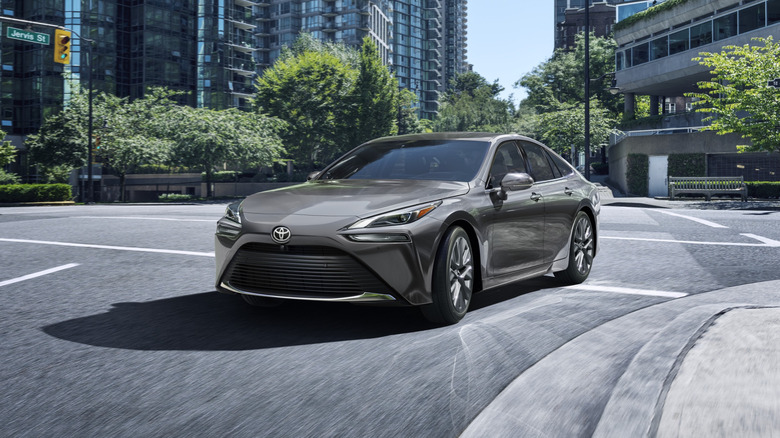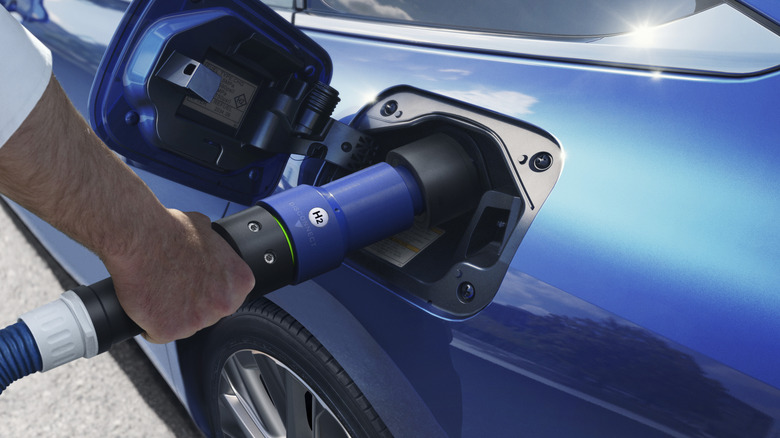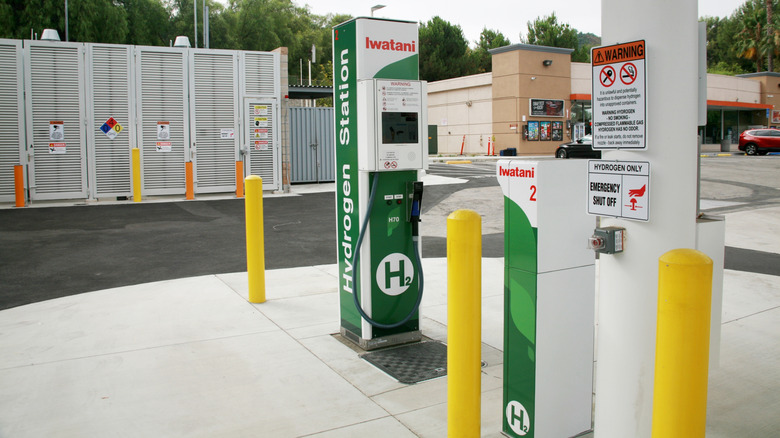How Long Has Toyota Been Developing Its Hydrogen Engine And Why Isn't It Popular?
Hydrogen vehicles were supposed to be a clean, practical way of powering the cars of the future. Theoretically, the idea seems great: Hydrogen fuel cell electric vehicles, or FCEVs, generate electricity for their motors by reacting hydrogen fuel with oxygen from the surrounding air, so their only emissions are water vapor and heat.
They also only take a few minutes to refuel, around the same as a gas-powered car. Multiple FCEVs are sold in California, with Toyota, Honda, and Hyundai all selling their own hydrogen-powered vehicles in 2025. In reality though, FCEVs aren't the highly convenient green transport that drivers were promised.
Toyota has been developing hydrogen technology for decades, and unveiled its first FCEV in 1996, but the brand's first mass-market hydrogen model didn't arrive until 2014. It was called the Mirai, which is the Japanese word for future, and launched both in Japan and in select overseas markets including California.
The first examples were delivered to U.S. customers by the end of 2015, with Toyota promising that the very limited hydrogen refueling infrastructure at the time would quickly be scaled up. Unfortunately, it was this limited infrastructure that proved to be the biggest stumbling block for increasing the Mirai's popularity, and it's also holding back Toyota from developing its fascinating hydrogen-powered internal combustion engine, which has been in development since 2021.
To be popular, it must be practical
Despite having a very limited market for the technology, Toyota hasn't given up developing its hydrogen engine just yet. In 2024, the company showed off a concept GR Corolla race car powered by liquid hydrogen, which offers increased efficiency, as its engine reuses boil-off gas that would previously have been wasted.
The boil-off gas is channeled to a small fuel cell, which then generates electricity to supplement the power provided by the liquid hydrogen engine. Yamaha and Toyota also announced a partnership to build a hydrogen-powered V8 engine in 2022, which will be based on Lexus' existing 5.0-liter V8 design.
At the time of the Mirai's launch, according to the University of California, just 68 hydrogen refueling stations in California would be enough to cater for up to 10,000 hydrogen vehicles. It claimed that by the end of 2016, the state would have 48 stations in place, with the implication that more would open soon after. However, this proved to be overly optimistic, and the resulting lack of infrastructure would end up having significant implications for Mirai owners.
At the time of writing, data from the Department of Energy shows just 53 hydrogen stations available in California, with a further four listed as temporarily unavailable. The vast majority of those stations are clustered around Los Angeles or the San Francisco Bay Area. Outside of those areas, refueling opportunities are very sparse, with the most northerly point of the state's network being a single refueling station in Sacramento.
What does the future look like for hydrogen vehicles?
Given the increasing number of battery EVs on the market and the rapid broadening of the EV charging network, it's hard to find reasons why buyers would want to pick a hydrogen vehicle in 2025.
Prices for hydrogen fuel in California have doubled in the space of a few years, and even though Toyota is now offering new Mirai buyers $15,000 worth of free fuel, the limited availability of hydrogen refueling stations means that getting that fuel isn't easy either.
However, outside of potential motorsport uses, these latest developments have very limited usefulness if public refueling infrastructure doesn't improve. The workings of a hydrogen engine might be impressive from a technological standpoint, but that won't be enough to make them popular if drivers can't quickly and easily refuel their car. For now, they can't, and so Toyota's hydrogen offerings remain a niche and increasingly uncompetitive choice.


